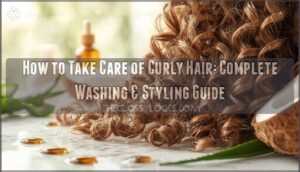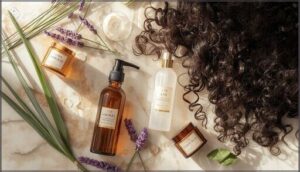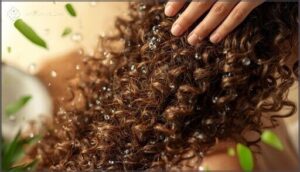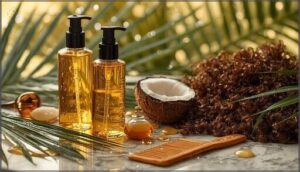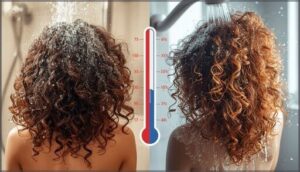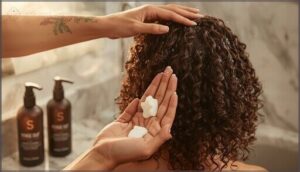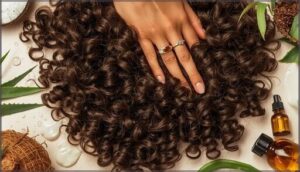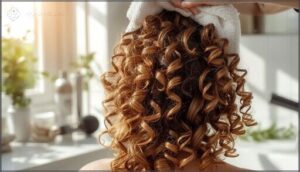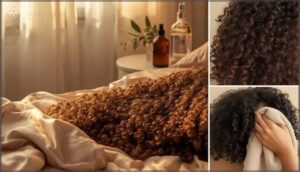This site is supported by our readers. We may earn a commission, at no cost to you, if you purchase through links.
Your curls don’t follow the same rules as straight hair. The spiral shape means natural oils from your scalp can’t travel down the hair shaft easily. This leaves your ends dry and thirsty while your roots might feel fine.
That curved follicle also creates a cuticle that lifts more easily, opening the door to frizz and breakage. Understanding how your hair actually works changes everything about how you care for it.
The right approach to washing, conditioning, and styling protects your curls instead of fighting against their natural structure. Small shifts in your routine can mean the difference between defined spirals and a frizzy mess.
Table Of Contents
Key Takeaways
- Curly hair’s spiral structure prevents natural oils from reaching the ends, making it chronically dry and more prone to breakage than straight hair—requiring sulfate-free shampoos and moisture-rich conditioners to compensate.
- Wash your curls only 1-2 times per week with lukewarm water, apply conditioner from mid-lengths to ends, and use deep conditioning treatments weekly to prevent the dryness that leads to frizz and damage.
- Detangle curly hair only when it’s damp and conditioned using a wide-tooth comb or your fingers, working from the ends upward to minimize the breakage that happens 5-50 times easier than with straight hair.
- Protect your curls overnight with silk or satin pillowcases that reduce friction by up to 43%, and refresh between washes using light misting and curl cream instead of rewashing to maintain definition.
Key Differences in Curly Vs. Straight Hair
Curly hair isn’t just straight hair with a different shape. The structure of each curl creates real challenges that affect how you care for your hair every day.
Understanding these key differences helps you make better choices about products and routines that actually work.
Why Curly Hair is Drier
Because curly hair grows from curved follicles, sebum can’t travel down the shaft as easily as it does in straight hair. The cuticle structure in curls is often more lifted, which lets moisture escape faster. Hair curvature also increases the surface area exposed to air, speeding up water loss and leaving your curls feeling chronically dry. The follicle’s retrocurvature greatly impacts hair texture.
| Factor | Straight Hair | Curly Hair |
|---|---|---|
| Sebum distribution | Even root to tip | Limited toward ends |
| Cuticle structure | Smooth and compact | Lifted and irregular |
| Moisture retention | Higher water content | Faster evaporation |
Increased Fragility and Breakage
That dryness leads to a bigger problem: hair breakage. Curly hair shows weaker cuticle adhesion and needs 5 to 50 times more force to comb than straight strands. Tight curl patterns like 4c are even more vulnerable. When you brush wet curly hair, you’re pulling at fragile fibers that stretch unevenly and snap faster—96% of women with afro-textured hair report breakage. The internal structure impacts the curliness of Afro-textured hair.
| Issue | Impact on Curly Hair |
|---|---|
| Cuticle Weakness | Lower glycoprotein = poor adhesion |
| Grooming Damage | Tension and shear create internal cracks |
| Wet Fragility | Moisture makes hair stretch and break easily |
| Kinky Vulnerability | Tightest curls break 10× faster under stress |
Managing Frizz and Flyaways
That breakage sets the stage for another frustration: frizz and flyaways. High humidity causes your cuticles to lift and swell, letting moisture rush in. About 65% of curly-haired people deal with frizz regularly. High porosity curls grab water from the air and lose definition fast. Humidity control and cuticle care matter. Gels with strong hold seal cuticles and cut frizz by 80%. Apply products to damp hair evenly and don’t touch curls while diffusing.
| Strategy | How It Helps |
|---|---|
| Anti-humectant products | Block moisture in high dew points |
| Deep conditioning weekly | Smooth cuticles and retain moisture |
| Sulfate-free shampoos | Preserve natural barrier against frizz |
| Oil sealing post-styling | Ward off environmental frizz |
Choosing The Best Products for Curly Hair
The products you choose can make or break your curly hair routine. Not all shampoos and conditioners work the same way on curls, and some ingredients can actually do more harm than good.
Here’s what to look for when you’re shopping for curly hair products.
Sulfate-Free Shampoo Options
Choosing hair products wisely means reaching for sulfate-free shampoo formulations that won’t strip your curls. These gentle cleansers use milder sulfate alternatives like coco-glucoside and decyl glucoside to remove dirt without causing dryness. Market trends show 70% of people with curly hair prefer these options.
Look for:
- Aloe vera for hydration
- Shea butter to seal moisture
- Glycerin to attract humidity
- Natural oils like coconut or jojoba
Moisture-Boosting Conditioners
Most curl care routines succeed or fail based on conditioner choice. Moisture-boosting formulas with shea butter and coconut oil increase hydration by up to 30% compared to standard products. These conditioners reduce breakage by 40% while improving curl definition by 35%.
| Ingredient | Hydration Boost | Key Benefit |
|---|---|---|
| Shea Butter | Up to 20% elasticity gain | Seals moisture and reduces frizz |
| Coconut Oil | 50% less protein loss | Strengthens and protects curls |
| Argan Oil | 33% dryness reduction | Adds shine and softness |
| Aloe Vera | 22% moisture increase | Reduces static in dry climates |
| Glycerin | 40% hydration improvement | Attracts and locks in water |
Deep condition once weekly for healthy curls. Daily lightweight application works for fine hair, while thicker textures benefit from every-other-day conditioning. Leave the product on wet hair for 3–5 minutes before rinsing with cool water to get the most absorption.
Ingredients to Look for and Avoid
When shopping for sulfate-free shampoo and silicone-free conditioner, your ingredient list matters more than brand names. Look for humectants like glycerin and panthenol that attract moisture, plus nourishing oils such as argan and jojoba for hydration.
Avoid sulfates that strip natural oils, silicones causing buildup, and drying alcohols like ethanol.
Protein-rich ingredients strengthen curls but use them sparingly to prevent stiffness.
How to Wash and Condition Curly Hair
Washing curly hair the right way makes all the difference between bouncy defined curls and a frizzy mess. The key is understanding how often to wash, what temperature water to use, and how to apply conditioner without weighing down your curls.
Let’s break down the essential steps that will keep your curls healthy and hydrated.
Washing Frequency and Scalp Care
Finding the right hair washing frequency for curly hair matters more than you might think. Wash your curls 1-2 times per week to preserve natural oils and prevent dryness. Over-washing strips moisture and increases breakage risk.
Between washes, keep your scalp healthy with gentle massage to boost oil distribution and circulation. This balanced approach to scalp care protects your curls while maintaining scalp hydration.
Pre-Shampoo and Detangling Methods
Pre-poo oils like coconut or argan protect your hair before washing. Apply oil to dry strands, let it sit for 20-30 minutes, then gently detangle with your fingers or a wide-tooth comb.
Always start at the ends and work upward to prevent breakage. This detangler step locks in moisture retention while reducing breakage during shampooing—a simple upgrade that transforms curly hair care.
Temperature: Hot Vs. Cold Water
Water temperature matters more than you think for curly hair. Hot water strips natural oils and opens cuticles, causing dryness and frizz. Lukewarm benefits include gentle cleansing without damage, while cold water benefits seal moisture and boost shine.
Temperature practices should follow a two-step approach: wash with lukewarm water, then rinse cool. This hair washing technique preserves your curls’ health during hair cleansing routines.
Proper Use of Conditioner
Conditioner frequency matters—aim for 2–3 times weekly after every shampoo. Use a quarter-sized amount for medium-length curls, working product from roots to ends using praying hands or finger-raking application techniques.
Rinse-out vs leave-in conditioners serve different roles: rinse-out provides deep hydration, while leave-in maintains moisture impact throughout the day. Silicone-free conditioner prevents buildup and helps hair moisture retention.
Over-conditioning risks include hygral fatigue and weakened curls.
Effective Moisturizing and Conditioning Techniques
Keeping your curls hydrated goes beyond your basic wash-and-condition routine. You need products and techniques that actually lock in moisture and protect your hair from dryness throughout the week.
Here are four essential methods that will keep your curls soft, defined, and healthy.
Deep Conditioning and Hair Masks
Deep conditioning treatments work wonders for curly hair when used one to two times per week.
Hair masks with moisture-boosting ingredients and occasional protein balance keep your curls soft and strong.
Apply the mask composition to damp hair from mid-lengths to ends, then add gentle heat application for better oil penetration. Leave it on for 15 to 30 minutes for best results.
Leave-in Conditioners for Curls
Leave-in conditioner is your daily moisture boost after washing. It helps with frizz control and breakage prevention by keeping your curls hydrated between washes.
Apply it to damp hair, focusing on mid-lengths and ends where dryness hits hardest. Look for lightweight formulas with conditioning polymers and plant-based ingredients that won’t weigh down your curl definition.
Section your hair and rake the product through for even hydration retention.
Using Natural Oils for Added Moisture
Natural oils bring powerful moisturizing benefits to your curls. Coconut and argan oil penetrate deeply to hydrate from within, while jojoba and castor oil act as sealing oils that lock in moisture. These oils support scalp health and strengthen fragile strands. Apply them to damp hair after conditioning to boost oil penetration and absorption.
- Choose coconut or olive oil for deep moisture that reaches the hair shaft
- Use jojoba oil to mimic natural sebum and balance your scalp
- Apply argan oil as a finishing sealer to lock hydration in place
- Warm the oil between your palms before working through your curls
- Focus application on mid-lengths and ends where dryness strikes hardest
Preventing Product Build-Up
While oils add moisture, too much product leads to hair buildup that weighs down your curls. Choose a sulfate-free shampoo and silicone-free conditioner to prevent residue. Look for lightweight formulas with water-soluble ingredients in your hair care product ingredients. Apply product only to mid-lengths and ends during your curly hair washing routine.
Water softeners reduce mineral deposits, and regular scalp exfoliation removes buildup before it starts.
Styling and Drying Curly Hair Safely
Styling and drying are where many people accidentally undo all their hard work from washing and conditioning. The right techniques protect your curls from damage while helping them look their best.
Let’s walk through the essential steps to keep your hair healthy while styling it.
Detangling Tools and Methods
Your tool choice matters greatly for detangling curly hair. Wide-tooth combs outperform brushes, reducing breakage by 20–25% compared to fine-tooth options.
Start with finger detangling on damp, conditioned hair to separate large tangles gently. Work in small sections from ends upward, applying leave-in conditioner generously. This technique reduces combing force and prevents knots from tightening.
Wet detangling requires extra care since water weakens hair fibers, making a wide-tooth comb your best ally for minimizing damage.
Minimizing Heat Damage
Heat styling curly hair demands caution since temperatures above 180°C accelerate structural damage and brittleness. Always apply a heat protectant before using heat tools—studies show they reduce fiber temperature by about 9% and shield against drying.
To minimize cumulative damage:
- Start at 177°C (350°F) and increase only if needed
- Keep tools moving to avoid localized overheating
- Choose devices with precise temperature control
- Limit heat styling frequency
Tool selection and protecting hair from heat preserves your curl pattern long-term.
Air Drying Vs. Diffusing
Which drying method suits your curls best? Air drying takes over 2 hours and can cause structural damage through prolonged wetness—your hair weakens 30% more when wet for extended periods.
Diffusing cuts drying time by 50% and lifts roots for twice the volume.
After gently pressing with a microfiber towel, choose diffusing for fullness or air drying for elongated curls with less shrinkage.
Preserving Healthy Curls Day and Night
Taking care of your curls doesn’t stop after styling. The right habits between washes can make the difference between defined curls and a frizzy mess.
Here’s how to protect your curls around the clock and keep them looking their best.
Trimming to Prevent Split Ends
Regular haircuts are your best defense against split ends, which curly hair is especially prone to. Aim to trim every 8–12 weeks to stop damage from traveling up the shaft.
Here’s how to protect your curls:
- Use sharp hair shears for clean cuts that won’t create new splits
- Trim curls dry so you can see their natural shape
- Remove all visibly damaged ends to break the breakage cycle
- Pair trims with deep conditioning if you use heat or chemicals
Overnight Protection (Silk/Satin Accessories)
Your pillowcase can undo hours of styling. Cotton absorbs moisture and creates friction that causes up to 43% more breakage than silk. Switch to silk or satin accessories to preserve curls overnight.
| Accessory Type | Primary Benefit |
|---|---|
| Silk pillowcase | Reduces friction by up to 43% |
| Satin bonnet | Locks in moisture and products |
| Silk scarf | Full curl protection for all lengths |
| Satin scrunchie | Secures protective styles gently |
| Mulberry silk cap | Premium breathability and smoothness |
Pair these with the pineapple method—loosely gathering curls on top—to maintain definition while you sleep.
Reducing Frizz and Breakage
Frizz signals that moisture balance is off and cuticle integrity is compromised. Curly hair breaks more easily because its structure creates weak points where cuticles lift.
Frizz reveals compromised moisture balance and lifted cuticles that create weak points where curly hair breaks most easily
Gentle grooming with wide-tooth combs, protein treatments every few weeks, and protective styling like loose braids reduce mechanical stress. Focus on moisturizing hair with leave-in conditioners and avoiding harsh manipulation.
These steps work together to stop preventing hair breakage before it starts.
Maintaining Curl Definition Between Washes
You don’t need to rewash your hair to bring back bounce. Refresh techniques like light misting reactivate product and restore definition in minutes.
Try the pineapple method before bed—a loose high ponytail keeps curls intact overnight.
Product application matters too: a dime-sized curl cream smoothed through dry hair revives clumping without heaviness.
Wash frequency stays low while frizz stays under control with smart overnight protection.
Frequently Asked Questions (FAQs)
Can I brush my curly hair when dry?
Brushing dry curly hair isn’t ideal. Dry brushing damage increases breakage and frizz because curls resist separation without moisture.
Wet detangling benefits your hair more—hydration before brushing and proper technique reduces breakage considerably.
How often should I clarify curly hair?
Clarify your curly hair every 2–4 weeks depending on product types and water hardness.
Heavier butters or hard water may require clarifying every 2 weeks, while lightweight products extend intervals to 4–6 weeks based on buildup symptoms.
What causes curls to lose their pattern?
Your curly hair can lose its natural spiral when hormonal changes reshape follicles, environmental damage weakens strands, product buildup weighs down curls, mechanical stress from styling breaks bonds, or nutritional deficiencies affect hair moisture balance and porosity.
Should I use protein treatments on curls?
Yes, but balance is key. Protein treatments strengthen curls and reduce breakage when used every 4–6 weeks.
Watch for stiffness or dryness—signs of overload. Match treatment frequency to your hair porosity for best results.
Can swimming damage my curly hair routine?
Pool and ocean water can disrupt your curl maintenance by stripping moisture and raising hair porosity. Chlorine effects and saltwater damage make pre-swim protection and post-swim cleanse essential steps in any hair care routine.
Conclusion
Think of your curls like a garden that thrives when you work with the soil instead of against it. Learning how to take care of curly hair means respecting what your strands need rather than forcing them into routines made for someone else.
The techniques you’ve learned here give you the foundation to stop fighting frizz and start building definition. Your curls already know how to shine. Now you know how to help them.
- https://www.vichyusa.com/blog/skin-concern/scalp-care/how-often-should-i-wash-my-hair.html
- https://www.ilovericcio.com/en/blog/curly-hair-remedies/how-often-should-you-wash-curly-hair-to-avoid-losing-shape-and-volume/
- https://curlsmith.com/blogs/ingredients/changing-to-sulfate-free-shampoo
- https://pmc.ncbi.nlm.nih.gov/articles/PMC6489037/
- https://fixmycurls.com/blogs/curls/secrets-of-sulfate-free-why-curly-hair-adores-gentle-shampoos-and-nourishing-conditioners

